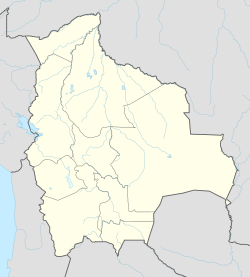Virgen de Urqupiña
| Quillacollo | |
|---|---|
 |
|
| Location within Bolivia | |
| Coordinates: 17°24′S 66°17′W / 17.400°S 66.283°W | |
| Country |
|
| Department | Cochabamba Department |
| Province | Quillacollo Province |
| Municipality | Quillacollo Municipality |
| Canton | Quillacollo Canton |
| Foundation | September 14, 1593 by Joan Zeñudo, José de Uribe, Cristóbal de Arévalo, Francisco de la Moya & Juan de Soliz |
| Incorporated (municipality) | 14 September 1905 |
| Government | |
| • Mayor | Carla Lorena Pinto (MAS-IPSP, interim, 2010) |
| • President | Marcelo Galindo Gómez (2007) |
| Area | |
| • Total | 566 km2 (219 sq mi) |
| Elevation | 2,425 m (7,956 ft) |
| Population (2012) | |
| • Total | 87,309 |
| • Density | 150/km2 (400/sq mi) |
Quillacollo is the capital of Quillacollo Province in Cochabamba Department, Bolivia. The municipality was established on 14 September 1905 under the Presidency of Ismail Montes.
The city of Quillacollo is located 13 km (8.1 mi) westward of Cochabamba City. Quillacollo's population is 74,980 based on the 2001 census. The National Statistics Institute estimated in 2010 that the population had grown unexpectedly rapidly to approximately 142,724. The increase in population makes Quillacollo the second fastest growing city in Bolivia after El Alto in La Paz.
Quillacollo City is one of the various provincial capitals around Cochabamba City, which are increasingly swallowed by the extending perimeter of "greater" Cochabamba (city).
Quillacollo is linked to the city of Cochabamba through the Avenida Blanco Galindo, a particularly busy stretch on the main national highway. Quillacollo is mostly a market town with a sizable agricultural hinterland, but also hosts some relevant industry and a district court which supports a relevant population of lawyers.
The Virgen de Urqupiña festival is held annually on August 15. It is officially dubbed the "Festival of National Integration" and sees a host of different activities, ranging from an extended folkloric spectacle, over a central Mass, generally attended by the Bolivian president and other authorities, to a huge popular pilgrimage in the course of which people profess their Catholic faith, but also engage in rituals which are commonly seen as standing in an uneasy relationship with Catholic orthodoxy at best, or being outright pagan. People pray and offer promises to the Virgin of Urqupiña for money, health and luck. People greet pachamama (mother earth) with alcohol and food, burying or spilling it on the floor. A curious rite held on this festivity is extracting rocks from a hill near the sanctuary of the Virgin, whether the rock is big or small, it has to be taken home with the people who cracked the rocky hill to get it, who must return it the next year, as a symbolic act to ask the Virgin to lend them something (like health, money, luck etc.).
...
Wikipedia

